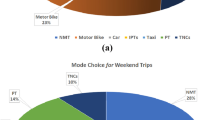Abstract
Ride-hailing is an emerging service that is transforming door to door mobility in urban areas. Users can easily request a ride through a smartphone app that informs them of the pickup time, the location of the vehicle, and the fare that they will pay in advance. Even though it is well known that Uber implements a dynamic pricing approach depending mostly on supply, demand and competition with other services, there is still little empirical evidence on the main drivers explaining the fare strategy of the company. However, a deeper understanding of prices is essential to evaluate and establish a future scenario with smarter regulation and fairer competition between ridesourcing and taxi services. Using 10-month data from the Uber’s application programming interface in the city of Madrid, this research studies the association of Uber fares with different explanatory variables. It also explores the main differences between Uber and taxi fares. The results indicate that trip distance, trip delay, day of the week, origin and destination of the trip, and rain precipitation have a statistically significant impact on Uber fares. The findings also show that on average, Uber fares are lower than taxi fares, with the exception of particular hours of the day, as well as Uber fares slightly increased during taxi strikes recently happened in Madrid. The paper concludes with some policy recommendations and insigths regarding the future of the hailing sector and the importance of prices in evaluating future changes and possibilities.





Similar content being viewed by others
Notes
VTC is a legal authorization to rent vehicles with drivers in Spain.
References
Agresti, A.: Foundations of Linear and Generalized Linear Models. Wiley, New York (2015)
Akimova, T., Arana-Landín, G., Heras-Saizarbitoria, I.: The economic impact of Transportation Network companies on the traditional taxi Sector: An empirical study in Spain. Case Stud. Transp. Policy. 8, 612–619 (2020). https://doi.org/10.1016/j.cstp.2020.02.002
Alemi, F., Circella, G., Handy, S., Mokhtarian, P.: What influences travelers to use Uber? Exploring the factors affecting the adoption of on-demand ride services in California. Travel Behav. Soc. 13, 88–104 (2018). https://doi.org/10.1016/j.tbs.2018.06.002
Ayuntamiento de Madrid: BOAM Boletín Oficial del Ayuntamiento de Madrid - Núm. 8293. España (2019a)
Ayuntamiento de Madrid: BOAM Boletín Oficial del Ayuntamiento de Madrid - Núm. 8546. España (2019b)
Ayuntamiento de Madrid: Población por distrito y secciones censales (2020). http://www-2.munimadrid.es/TSE6/control/seleccionDatosSeccion. Accessed 12 Mar 2020
Berger, T., Chen, C., Frey, C.B.: Drivers of disruption? Estimating the Uber effect. Eur. Econ. Rev. 110, 197–210 (2018). https://doi.org/10.1016/j.euroecorev.2018.05.006
Brodeur, A., Nield, K.: An empirical analysis of taxi, Lyft and Uber rides: evidence from weather shocks in NYC. J. Econ. Behav. Organ. 152, 1–16 (2018). https://doi.org/10.1016/j.jebo.2018.06.004
Chen, L.: Measuring Algorithms in Online Marketplaces (2017). https://cbw.sh/static/pdf/chen-thesis.pdf. Accessed 22 Feb 2020
Chen, M.K., Sheldon, M.: Dynamic Pricing in a Labor Market: Surge Pricing and the Supply of Uber Driver-Partners (2015). http://citeseerx.ist.psu.edu/viewdoc/download?doi=10.1.1.704.3600&rep=rep1&type=pdf. Accessed 18 Feb 2020
Chen, M.K., Sheldon, M.: Dynamic pricing in a labor market: surge pricing and flexible work on the uber platform. In: Proceedings of the 2016 ACM Conference on Economics and Computation (2016). https://doi.org/10.1145/2940716.2940798
Clewlow, R.R., Mishra, G.S.: Disruptive Transportation: The Adoption, Utilization, and Impacts of Ride-Hailing in the United States. Institute of Transportation Studies, University of California, Davis, Research Report UCD-ITS-RR-17-07 (2017)
Consorcio Regional de Transportes de Madrid: Encuesta de Movilidad de la Comunidad de Madrid 2018. Documento síntesis, Madrid (2019)
Cramer, J., Krueger, A.B.: Disruptive change in the taxi business: the case of Uber. Am. Econ. Rev. 106, 177–182 (2016). https://doi.org/10.1257/aer.p20161002
Erhardt, G.D., Roy, S., Cooper, D., Sana, B., Chen, M., Castiglione, J.: Do transportation network companies decrease or increase congestion? Sci. Adv. 5, eaau2670 (2019). https://doi.org/10.1126/sciadv.aau2670
Gehrke, S.R., Felix, A., Reardon, T.: Fare Choices: A Survey of Ride-Hailing Passengers in Metro Boston. Boston (2018)
Gong, J., Song, Y.: Uber might buy me a Mercedes Benz: an empirical investigation of the sharing economy and durable goods purchase. SSRN Electron. J. (2017). https://doi.org/10.2139/ssrn.2971072
Goodspeed, R., Xie, T., Dillahunt, T.R., Lustig, J.: An alternative to slow transit, drunk driving, and walking in bad weather: an exploratory study of ridesourcing mode choice and demand. J. Transp. Geogr. 79, 102481 (2019). https://doi.org/10.1016/j.jtrangeo.2019.102481
Gramaglia, M., Trullols-Cruces, O., Naboulsi, D., Fiore, M., Calderon, M.: Mobility and connectivity in highway vehicular networks: a case study in Madrid. Comput. Commun. 78, 28–44 (2016). https://doi.org/10.1016/j.comcom.2015.10.014
Gujarati, D.N., Porter, D.C.: Basic Econometrics. McGraw-Hill, New York (2009)
Hall, J., Kendrick, C., Nosko, C.: The Effects of Uber ’s Surge Pricing : A Case Study request a ride. The University of Chicago Booth School of Business (2015)
Henao, A.: Impactos of ridesourcing—LYFT and UBER—on transportation including VMT, Mode Replacement, Parking and Travel Behavior (2017). http://digital.auraria.edu/content/AA/00/00/60/55/00001/Henao_ucdenver_0765D_10823.pdf. Accessed 12 Mar 2020
Hughes, R., MacKenzie, D.: Transportation network company wait times in Greater Seattle, and relationship to socioeconomic indicators. J. Transp. Geogr. 56, 36–44 (2016). https://doi.org/10.1016/j.jtrangeo.2016.08.014
Jiao, J.: Investigating Uber price surges during a special event in Austin, TX. Res. Transp. Bus. Manag. 29, 101–107 (2018). https://doi.org/10.1016/j.rtbm.2018.02.008
Jimenez, M.: Uber cambia sus tarifas en Madrid y baja el precio mínimo en dos euros (2019)
Lavieri, P.S., Bhat, C.R.: Investigating objective and subjective factors influencing the adoption, frequency, and characteristics of ride-hailing trips. Transp. Res. Part C Emerg. Technol. 105, 100–125 (2019). https://doi.org/10.1016/j.trc.2019.05.037
Ministerio de Fomento: Distribución de Autorizaciones por Provincia y Clase. Madrid (2020)
Mohamed, M.J., Rye, T., Fonzone, A.: Operational and policy implications of ridesourcing services: a case of Uber in London, UK. Case Stud. Transp. Policy. (2019). https://doi.org/10.1016/j.cstp.2019.07.013
Ngo, V.D.: Transportation network companies and the ridesourcing industry: a review of impacts and emerging regulatory frameworks for Uber. Presented at the (2015)
Nie, Y.: (Marco): how can the taxi industry survive the tide of ridesourcing? Evidence from Shenzhen, China. Transp. Res. Part C Emerg. Technol. 79, 242–256 (2017). https://doi.org/10.1016/j.trc.2017.03.017
Oliveira, T.A., Kitsos, C.P., Oliveira, A., Grilo, L.: Recent Studies on Risk Analysis and Statistical Modeling. Springer, New York (2018)
Peck, J.: New York City Drunk Driving After Uber. New York (2017)
Pepić, L.: The sharing economy: Uber and its effect on taxi companies. ACTA Econ. (2018). https://doi.org/10.7251/ACE1828123P
Rayle, L., Dai, D., Chan, N., Cervero, R., Shaheen, S.: Just a better taxi? A survey-based comparison of taxis, transit, and ridesourcing services in San Francisco. Transp. Policy. 45, 168–178 (2016). https://doi.org/10.1016/j.tranpol.2015.10.004
Shaheen, S., Cohen, A., Zohdy, I.: Shared Mobility: Current Practices and Guiding Principles. Fhwa-Hop-16-022 2 (2016)
Shokoohyar, S., Sobhani, A., Sobhani, A.: Impacts of trip characteristics and weather condition on ride-sourcing network: evidence from Uber and Lyft. Res. Transp. Econ. 80, 100820 (2020). https://doi.org/10.1016/j.retrec.2020.100820
Smart, R., Rowe, B., Hawken, A., Kleiman, M., Mladenovic, N., Gehred, P., Manning, C.: Faster and Cheaper: How Ride-Sourcing Fills a Gap in Low-Income Los Angeles Neighborhoods. BOTEC Analysis Corp, Cambridge (2015)
Tirachini, A., del Río, M.: Ride-hailing in Santiago de Chile: users’ characterisation and effects on travel behaviour. Transp. Policy. 82, 46–57 (2019). https://doi.org/10.1016/j.tranpol.2019.07.008
Vassallo, J.M., Baeza, M., de Los, Á., Ortega, A.: What was wrong with the toll highway concessions in the Madrid metropolitan area? Can. J. Civ. Eng. 39, 81–90 (2012). https://doi.org/10.1139/L11-113
Vassallo, J.M., Gomez, J., Aguilera, A.: Ride-hailing en España: ¿Qué opinan los usuarios de Uber y Cabify frente al taxi? Rev. Obras Publicas. 165, 24–29 (2018)
Wang, M., Mu, L.: Spatial disparities of Uber accessibility: an exploratory analysis in Atlanta, USA. Comput. Environ. Urban Syst. 67, 169–175 (2018). https://doi.org/10.1016/j.compenvurbsys.2017.09.003
Wenzel, T., Rames, C., Kontou, E., Henao, A.: Travel and energy implications of ridesourcing service in Austin, Texas. Transp. Res. Part D Transp. Environ. 70, 18–34 (2019). https://doi.org/10.1016/j.trd.2019.03.005
Yu, H., Peng, Z.-R.: Exploring the spatial variation of ridesourcing demand and its relationship to built environment and socioeconomic factors with the geographically weighted Poisson regression. J. Transp. Geogr. 75, 147–163 (2019). https://doi.org/10.1016/j.jtrangeo.2019.01.004
Funding
This work was supported by the Comunidad de Madrid, which has funded the Project Y2018/EMT-4818 (Co-Mov/CM). The project has also been co-funded by the European FEDER and FSE funds.Fernando Romero is also grateful for his research grant (BES-2016-077150) funded by the Spanish Ministry of Economy and Competitiveness and the European Social Fund.
Author information
Authors and Affiliations
Contributions
Thais Rangel: Conceptualization, Methodology, Formal Analysis, Investigation, Visualization, Writing—Original Draft, Writing – Review & Editing. Juan Nicolas Gonzalez: Methodology, Data Curation, Formal Analysis, Writing – Original Draft. Juan Gomez: Conceptualization, Methodology, Formal Analysis, Writing – Review & Editing. Fernando Romero: Conceptualization, Methodology, Data Curation, Formal Analysis, Writing – Original Draft. Jose Manuel Vassallo: Definition of the research idea, supervision, Writing – Review & Editing.
Corresponding author
Ethics declarations
Conflict of interest
On behalf of all authors, the corresponding author states that there is no conflict of interest.
Additional information
Publisher's Note
Springer Nature remains neutral with regard to jurisdictional claims in published maps and institutional affiliations.
Rights and permissions
About this article
Cite this article
Rangel, T., Gonzalez, J.N., Gomez, J. et al. Exploring ride-hailing fares: an empirical analysis of the case of Madrid. Transportation 49, 373–393 (2022). https://doi.org/10.1007/s11116-021-10180-w
Accepted:
Published:
Issue Date:
DOI: https://doi.org/10.1007/s11116-021-10180-w




